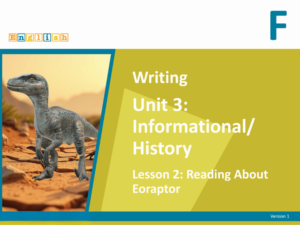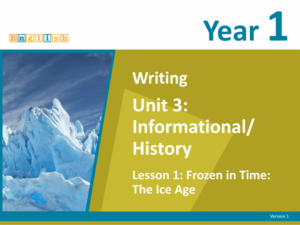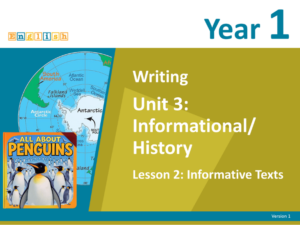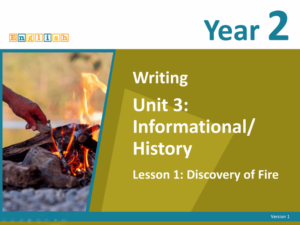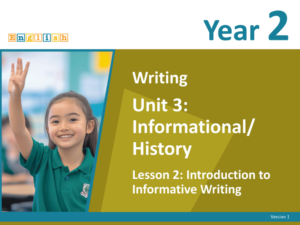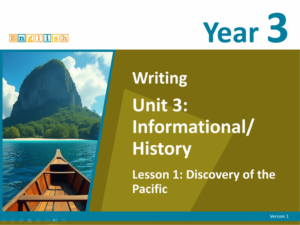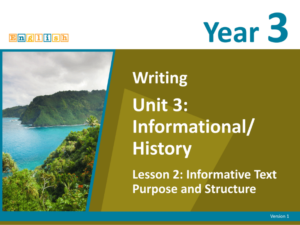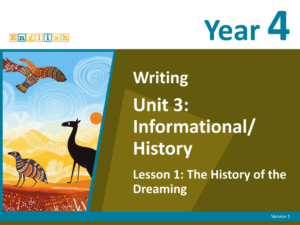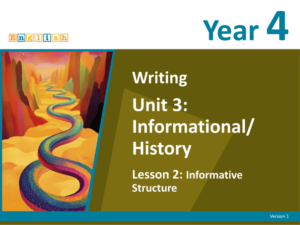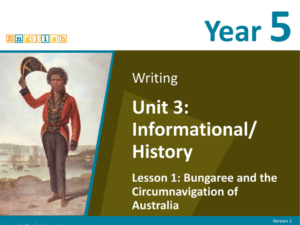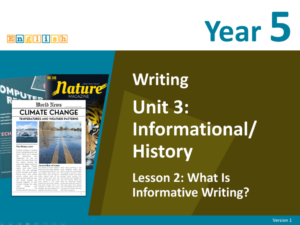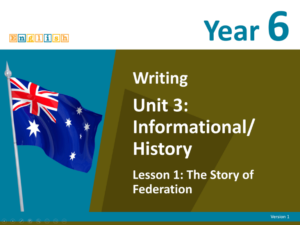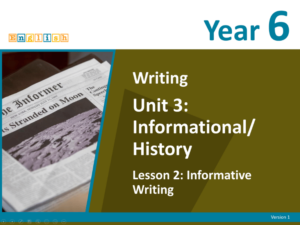English Writing, Informational (History), Unit 3
Foundation – Year 6
One of Our Most Exciting and Interactive Units Yet
This ACARA-aligned unit uses direct and explicit instruction to teach students informative writing. Through engaging historical content and interactive lessons, students learn text structure, fact identification, strong subtopics, and clarity through details and definitions. The unit concludes with students crafting, editing and refining their polished informative texts.
Why Choose Our English Writing, Informational (History), Unit 3?
Free and Ready-to-use
More than just lesson plans. Save time with complete lessons, workbooks, assessments and professional learning modules.
Inspire Future Writers
From dinosaurs and the Ice Age to explorers and Australian history, topics and lesson designs are age-appropriate, exciting and motivating.
Cross-Curricular
Cover two subjects and standards in one go. Declutter the Curriculum with this one English Writing Unit that covers English Writing and History.
Visually Outstanding Design That Inspires Writing
Animated visuals that are not only beautiful but also evidence-based and proven to engage students. English Writing Unit 3 utilises mind maps inspired by Tony Buzan, alongside high-quality graphics, exemplar texts and age-appropriate topics that support even the most reluctant writers in finding their writing confidence.
👉 Explore the carousel below to see examples from our Years Foundation to Year 6 lessons.
English Writing, Informational (History), Unit 3
Foundation – Year 6
Starter Lessons
Unit Overviews
Foundation Year: Informational (History)
Year F, Lesson 1
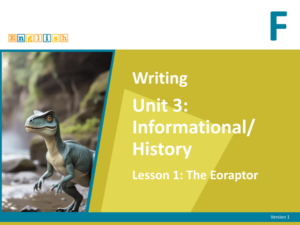
Teaching Resources
Australian Curriculum Content Descriptions
Bones of Giants:
Learn about prehistoric life and explore the fascinating world of dinosaurs. Students will identify features of informative texts and practice writing short, structured responses. They will also learn how to separate fact from imagination.
It aligns to the Australian Curriculum: Language and Literacy Content Strands:
- AC9EFLA03 Understand that texts can take many forms such as signs, books and digital texts.
- AC9EFLA05 Recognise that sentences are key units for expressing ideas.
- AC9EFLA06 Recognise that sentences are made up of groups of words that work together in particular ways to make meaning.
- AC9EFLA07 Explore the contribution of images and words to meaning in stories and informative texts.
- AC9EFLA08 Recognise and develop awareness of vocabulary used in familiar contexts related to everyday experiences, personal interests and topics taught at school.
- AC9EFLA09 Identify punctuation as a feature of written text different from letters; recognise that capital letters are used for names, and that capital letters also signal the beginning of sentences while punctuation marks signal the end.
- AC9EFLY03 Identify some differences between imaginative and informative texts.
- AC9EFLY05 Use comprehension strategies such as visualising, predicting, connecting, summarising and questioning to understand and discuss texts listened to, viewed or read independently.
- AC9EFLY06 Create and participate in shared editing of short written texts to record and report ideas and events using some learnt vocabulary, basic sentence‑boundary punctuation and spelling some consonant–vowel–consonant words correctly.
Learning Topics
In lessons 1 to 40, students learn to:
- Understand the purpose of informative writing.
- Recognise the basic structure of an informative text.
- Learn about dinosaurs from the Triassic, Jurassic, and Cretaceous periods, including their features, habitats, and adaptations.
- Share information by drawing, labelling, and writing short fact sentences.
- Use topic words to communicate ideas clearly in speaking and writing.
- Use capital letters and full stops correctly in simple sentences.
- Add more than one related fact to build on a topic.
- Organise ideas with support using concept maps to show information with pictures and words.
- Present writing and diagrams to others to explain information and ideas.
Success Criteria
- Tell that the purpose of informative writing is to share true information.
- Tell the structure of informative writing.
- Look at the title to find out the topic of a text.
- Draw and label a picture to share information.
- Write a title that tells what the writing is about.
- Use labels to write a simple fact sentence.
- Use topic words in writing.
- Start a sentence with a capital letter and end it with a full stop.
- Write two facts that are related to the topic.
- Use an editing checklist to make writing better.
- Share writing with others.
Assessment
Progress Tests
Exit Tickets
Exit tickets are taken on the first three days of each week at the end of the lesson. They allow teachers to monitor student understanding of the concepts taught and to identify where reteaching is needed.
End-of-Unit Assessment (History)
Week 9 students take a summative assessment over the historical content of the unit. This assessment is multiple-choice. The Teaching Guide contains the testing questions and the End-of-Unit Assessment handout for students to write their answers on.
End-of-Unit Assessment (English)
In Week 9, the unit culminates in students going through the writing steps to plan and write two fact sentences comparing two dinosaurs of their choice. The Teaching Guide contains the step-by-step teacher notes, the student assessment handout, and the marking guide.
Year 1: Informational (History)
Teaching Resources
Australian Curriculum Content Descriptions
Frozen in Time
Discover the Ice Age’s impact on humans and animals, connecting past and present. Students will practice reading and writing informational texts inspired by historical and scientific insights, add in diagrams to explain ideas and put their facts together into a clear paragraph.
It aligns to the Australian Curriculum: Language and Literacy Content Strands:
- AC9E1LA03 Explore how texts are organised according to their purpose, such as to recount, narrate, express opinion, inform, report and explain.
- AC9E1LA06 Understand that a simple sentence consists of a single independent clause representing a single event or idea.
- AC9E1LA08 Compare how images in different types of texts contribute to meaning.
- AC9E1LA09 Recognise the vocabulary of learning area topics.
- AC9E1LA10 Understand that written language uses punctuation such as full stops, question marks and exclamation marks, and uses capital letters for familiar proper nouns.
- AC9E1LY03 Describe some similarities and differences between imaginative, informative and persuasive texts.
- AC9E1LY05 Use comprehension strategies such as visualising, predicting, connecting, summarising and questioning when listening, viewing and reading to build literal and inferred meaning by drawing on vocabulary and growing knowledge of context and text structures.
- AC9E1LY02 Use interaction skills including turn-taking, speaking clearly, using active listening behaviours and responding to the contributions of others, and contributing ideas and question.
Learning Topics
By the end of this unit, students will be able to:
- Understand the purpose and structure of an informative text.
- Plan what to write using their knowledge of the structure of informative texts.
- Recognise the topic by reading the title.
- Identify the topic sentence.
- Write a title, a topic sentence and fact sentences using the 5Ws and 1H structure.
- Share information using words and pictures
- Label pictures to make diagrams, providing more information.
- Use capital letters for the names of important people and places.
- Check that facts are true and can be proven and understand the difference between a fact and an opinion.
- Use an Editing Checklist to improve their writing.
Success Criteria
- I can identify the purpose and structure of an informative text.
- I can use the informative structure to plan what we write.
- I know what the topic is by reading the title.
- I can write a title to reflect the topic.
- I can recognise topic words in the text.
- I can identify focus (topic) sentence.
- I can write a focus (topic) sentence to introduce the topic.
- I can write a sentence that shares a fact about the topic.
- I can write sentences (paragraph) that tell facts about the topic.
- I can share information with words and pictures.
- I can label drawings/pictures to give more information.
- I can reread writing to check that facts are accurate and only facts (not my opinion).
- I can write using capital letters for the names of people and places.
- I can make writing better by using an Editing Checklist.
Assessment
Exit Tickets
Exit tickets are taken the first three days of each week at the end of the lesson. They allow teachers to monitor student understanding of the concepts taught and to identify where reteaching is needed.
End-of-Unit Assessment (History)
In Week 9, students take a summative assessment over the historical content of the unit. This assessment is multiple-choice and uses on images to support students’ understanding. The Teaching Guide contains the step-by-step teacher notes for the history summative assessment lesson, test questions and the End-of-Unit Assessment handout for students to write their answers on, and the marking guide.
End-of-Unit Assessment (English)
In Week 9, the unit culminates in students using a mind map plan to plan and write an informative paragraph, which includes a title and diagram and editing their paragraph using an Editing Checklist.
The Teaching Guide contains the step-by-step teacher notes for the English summative assessment lessons, and the marking guide. The Informative Assessment Workbook is provided for each student with I Do, We Do examples to support the independent assessment tasks.
Year 2: Informational (History)
Teaching Resources
Australian Curriculum Content Descriptions
Spart of Genius
Delve into human innovation by exploring key inventions like the wheel and X-rays. Students will enhance their skills by creating well-structured informative texts on groundbreaking ideas whilst exploring the purpose of informative writing and build confidence by brainstorming and selecting strong subtopics.
It aligns to the Australian Curriculum: Language and Literacy Content Strands:
- AC9E2LA03 Identify how texts across the curriculum are organised differently and use language features depending on purposes.
- AC9E2LA08 Understand that images add to or multiply the meanings of a text.
- AC9E2LA09 Experiment with and begin to make conscious choices of vocabulary to suit the topic.
- AC9E2LE05 Create and edit literary texts by adapting structures and language features of familiar literary texts through drawing, writing, performance and digital tools.
- AC9E2LY01 Identify how similar topics and information are presented in different types of texts.
- AC9E2LY05 Use comprehension strategies such as visualising, predicting, connecting, summarising, monitoring and questioning to build literal and inferred meaning.
- AC9E2LY06 Create and edit short imaginative, informative and persuasive written and/or multimodal texts for familiar audiences, using text structure appropriate to purpose, simple and compound sentences, noun groups and verb groups, topic-specific vocabulary, simple punctuation and common 2-syllable words.
Learning Topics
In lessons 1 to 10, students learn to:
- Explain why fire was an important discovery.
- Identify the purpose of informative writing.
- Identify the features of informative writing.
- Identify an informative text when told what the book is about.
- Design a cover for an informative text.
- Explain how tools help humans live and work.
- Identify parts of a diagram.
- Explain what a topic is.
- Name two strategies that can be used to come up with topic words.
- Come up with topic words for a given topic.
Success Criteria
- Identify the purpose and structure of an informative text.
- Write and edit an informative text.
- Read timelines.
- Explain how technological developments changed people’s lives at home, and in the ways they worked, travelled and communicated.
Assessment
Exit Tickets
Exit tickets are taken the first three days of each week at the end of the lesson. They allow teachers to monitor student understanding of the concepts taught and to identify where reteaching is needed.
End-of-Unit Assessment
Week 9 students take a summative assessment over the historical content of the unit. This assessment is multiple-choice. The Teaching Guide contains the testing questions and the End-of-Unit Assessment handout for students to write their answers on.
Year 3: Informational (History)
Teaching Resources
Australian Curriculum Content Descriptions
Into the Unknown
Discover the stories of explorers who shaped our understanding of the world. Students will read historical accounts and write informational texts about key expeditions and advancements, Students will learn how to plan and organise ideas, select strong subtopics and practice turning facts into clear, well-structured writing.
It aligns to the Australian Curriculum: Language Content Strands:
- AC9E3LA03 Describe how texts across the curriculum use different language features and structures relevant to their purpose.
- AC9E3LA09 Identify how images extend the meaning of a text.
- AC9E3LA10 Extend topic‑specific and technical vocabulary and know that words can have different meanings in different contexts.
- AC9E3LY03 Identify the audience and purpose of imaginative, informative and persuasive texts through their use of language features and/or images.
- AC9E3LY05 Use comprehension strategies such as visualising, predicting, connecting, summarising, monitoring and questioning to build literal and inferred meaning.
- AC9E3LY06 Plan, create, edit and publish imaginative, informative and persuasive written and multimodal texts, using visual features, appropriate form and layout, with ideas grouped in simple paragraphs, mostly correct tense, topic‑specific vocabulary and correct spelling of most high‑frequency and phonetically regular words.
Learning Topics
By the end of this unit, students will be able to:
- Understand the purpose of informative writing and identify the intended audience.
- Plan and structure an informative text with an introduction, body paragraphs and a conclusion.
- Group related information into clear paragraphs, with each paragraph focusing on one idea.
- Include relevant facts and details to explain their topic clearly.
- Use topic-specific vocabulary to make their writing more informative.
- Expand sentences by adding descriptive noun groups and verb groups for detail.
- Use text features such as headings, subheadings or diagrams to organise information effectively.
- Edit their writing for correct spelling, punctuation and grammar.
- Use mind-maps to understand history concepts and organise writing.
- Use diagrams and timelines to better understand concepts in informative text.
Success Criteria
- I can identify the purpose and audience for my informative text.
- I can identify the structure of an informative text.
- I can write an introduction that tells the reader what my topic is about.
- I can write a conclusion that wraps up my informative text.
- I can organise my ideas into clear paragraphs (one idea per paragraph).
- I can include at least three factual details or pieces of information about my topic.
- I can use topic-specific words (technical vocabulary) to explain my ideas.
- I can use time order, headings or other text features to help organise my writing (if needed for the topic).
- I can reread and edit my writing to check for spelling, punctuation and grammar mistakes.
- I can use mind-maps to help organise my writing.
- I can use diagrams and timelines to better understand concepts in informative text.
Assessment
Exit Tickets
Exit tickets are taken the first three days of each week at the end of the lesson. They allow teachers to monitor student understanding of the concepts taught and to identify where reteaching is needed.
End-of-Unit Assessment
Week 9 students take a summative assessment over the historical content of the unit. This assessment is multiple-choice. The Teaching Guide contains the testing questions and the End-of-Unit Assessment handout for students to write their answers on.
Year 4: Informational (History)
Teaching Resources
Australian Curriculum Content Descriptions
The Discovery of Australia: Australian History from Time Immemorial to 1800s
Learn about the diversity of experiences in Australian history from time immemorial to the 1800s. Students will interpret sources and create well-structured informational texts, building confidence and independence as writers.
It aligns to the Australian Curriculum: Language and Literacy Content Strands:
- ACELA1490: Text structure and organisation: Understand how texts vary in complexity and technicality depending on the approach to the topic, the purpose and the intended audience.
- AC9E4LA01 Explore language used to develop relationships in formal and informal situations.
- AC9E4LA02 Identify the subjective language of opinion and feeling, and the objective language of factual reporting.
- AC9E4LA05 Identify text navigation features of online texts that enhance readability including headlines, drop-down menus, links, graphics and layout.
- AC9E4LY03 Identify the characteristic features used in imaginative, informative and persuasive texts to meet the purpose of the text.
- AC9E4LY06 Plan, create, edit and publish written and multimodal imaginative, informative and persuasive texts, using visual features, relevant linked ideas, complex sentences, appropriate tense, synonyms and antonyms, correct spelling of multisyllabic words and simple punctuation.
Learning Topics
By the end of this unit, students will be able to:
- Understand the purpose of informative writing and identify the intended audience
- Plan and structure an informative text with an introduction, body paragraphs, and a conclusion
- Group related information into clear paragraphs, with each paragraph focusing on one idea
- Include relevant facts and details to explain their topic clearly
- Use topic-specific vocabulary to make their writing more informative
- Expand sentences by adding descriptive noun groups and verb groups for detail
- Use text features such as headings, subheadings, or diagrams to organise information effectively
- Edit their writing for correct spelling, punctuation, and grammar
- Use mind maps to understand history concepts and organise writing
- Use diagrams and timelines to better understand concepts in informative text
- Apply these skills to write informative texts about Australian history, including significant events, people, and perspectives.
Success Criteria
- I can identify the purpose and audience for my informative text.
- I can identify the structure of an informative text.
- I can write an introduction that tells the reader what my topic is about.
- I can write a conclusion that wraps up my informative text.
- I can organise my ideas into clear paragraphs (one idea per paragraph).
- I can include at least three factual details or pieces of information about my topic.
- I can use topic-specific words (technical vocabulary) to explain my ideas.
- I can use time order, headings, or other text features to help organise my writing (if needed for the topic).
- I can reread and edit my writing to check for spelling, punctuation, and grammar mistakes.
- I can use mind-maps to help organize my writing.
- I can use diagrams and timelines to better understand concepts in informative text.
Assessment
Exit Tickets
Exit tickets are taken the first three days of each week at the end of the lesson. They allow teachers to monitor student understanding of the concepts taught and to identify where reteaching is needed.
End-of-Unit Assessment
Week 9 students take a summative assessment over the historical content of the unit. This assessment is multiple-choice. The Teaching Guide contains the testing questions and the End-of-Unit Assessment handout for students to write their answers on.
Year 5: Informational (History)
Teaching Resources
Australian Curriculum Content Descriptions
Encounters, Enterprise and Rebellion: Australian History from 1800 – 1900
Explore key events and diverse experiences in 19th-century Australia. Students will learn to collect, and analyse historical data whilst developing precise, well-crafted information texts.
It aligns to the Australian Curriculum: Language Content Strands:
- AC9E5LA03 Describe how spoken, written and multimodal texts use language features and are typically organised into characteristic stages and phases, depending on purposes in texts.
- AC9E5LA04 Understand how texts can be made cohesive by using the starting point of a sentence or paragraph to give prominence to the message and to guide the reader through the text.
- AC9E5LA08 Understand how vocabulary is used to express greater precision of meaning, including through the use of specialist and technical terms, and explore the history of words.
- AC9E5LY03 Explain characteristic features used in imaginative, informative and persuasive texts to meet the purpose of the text.
- AC9E5LY05 Use comprehension strategies such as visualising, predicting, connecting, summarising, monitoring and questioning to build literal and inferred meaning to evaluate information and ideas.
- AC9E5LY06 Plan, create, edit and publish written and multimodal texts whose purposes may be imaginative, informative and persuasive, developing ideas using visual features, text structure appropriate to the topic and purpose, text connectives, expanded noun groups, specialist and technical vocabulary, and punctuation including dialogue punctuation.
Learning Topics
In lessons 1 to 40, students learn to:
- Identify informative text structure, find key words and write strong titles
- Write a strong paragraph with a focus sentence
- Write paragraphs with descriptive details and factual evidence
- Write paragraphs for a specific audience using technical vocabulary and neutral language
- Write an introduction and a conclusion
- Use transition words to link ideas
- Identify information in diagrams and flowcharts
- Create diagrams
- Plan and write informative text
- Revise and edit informative text
- Plan, write, revise and edit informative text
Success Criteria
Share, develop, explain and elaborate on ideas from topics or historical texts.
Use informative text structure to organise, develop and link ideas.
Read, view and comprehend different texts created to inform audiences.
Create written texts for specific purposes and audiences, developing, explaining and elaborating on relevant ideas from topics or texts.
Assessment
Progress Tests
Exit Tickets
Exit tickets are taken the first three days of each week at the end of the lesson. They allow teachers to monitor student understanding of the concepts taught and to identify where reteaching is needed.
End-of-Unit Assessment
Week 9 students take a summative assessment over the historical content of the unit. This assessment is multiple-choice. The Teaching Guide contains the testing questions and the End-of-Unit Assessment handout for students to write their answers on.
Students also write and edit an informative text in Week 9, including a diagram. The Teaching Guide contains the marking rubric used to assess students’ writing.
Year 6: Informational (History)
Teaching Resources
Australian Curriculum Content Descriptions
The Lucky Country: Australia History from 1900 – Present Day
Examine the people and events that shaped Australia in the 20th century, including Federation and citizenship. Students will investigate sources and write structured, evidence-based texts.
English Writing Year 6 is an English unit for Year 6 students.
It aligns to the Australian Curriculum: Language Content Strands:
- AC9E6LA02: understand the uses of objective and subjective language identify bias
- AC9E6LA03: explain how texts across the curriculum are typically organised into characteristic stages and phases depending on purposes, recognising how authors often adapt text structures and language features
- AC9E6LY02: use interaction skills and awareness of formality when paraphrasing, questioning, clarifying and interrogating ideas, developing and supporting arguments sharing and evaluating information, experiences and opinions
- AC9E6LY03: analyse how text structures and language features work together to meet the purpose of a text engage and influence audiences
- AC9E6LY04: select, navigate and read texts for a range of purposes, monitoring meaning and evaluating the use of structural features; for example, table of contents, glossary, chapters, headings and subheadings
- AC9E6LY05: use comprehension strategies such as visualising, predicting, connecting, summarising, monitoring and questioning to build literal and inferred meaning to connect and compare content from a variety of sources
-
- AC9E6LY06: plan, create, edit and publish written and multimodal texts whose purposes may be imaginative, informative and persuasive, using paragraphs, a variety of complex sentences, expanded verb groups, tense, topic-specific and vivid vocabulary, punctuation, spelling and visual features
Learning Topics
By the end of this unit, students will be able to:
- Identify informative text structure, find key words and write strong titles.
- Write a strong paragraph with a focus sentence.
- Write paragraphs with descriptive details and factual evidence.
- Write paragraphs for a specific audience.
- Write an introduction and a conclusion.
- Write informative text using transitions.
- Plan and write informative text.
- Revise and edit informative text.
- Plan, write, revise and edit informative text.
Success Criteria
By the end of this unit, students will be able to:
- Share, develop, explain and elaborate on ideas from topics or historical texts.
- Use informative text structure to organise, develop and link ideas.
- Read, view and comprehend different texts created to inform audiences.
- Create written texts for specific purposes and audiences, developing, explaining and elaborating on relevant ideas from topics or texts.
Assessment
Exit Tickets
Exit tickets are taken the first three days of each week at the end of the lesson. They allow teachers to monitor student understanding of the concepts taught and to identify where reteaching is needed.
End-of-Unit Assessment
Week 9 students take a summative assessment over the historical content of the unit. This assessment is multiple-choice. The Teaching Guide contains the testing questions and the End-of-Unit Assessment handout for students to write their answers on.
In Week 8 and 9, students also follow the steps of the writing process to plan, draft, revise and edit their own informative text. The Teaching Guide contains the marking rubric used to assess students’ writing.
Other Writing Units
Lesson Design
Lesson Objective
Success Criteria
Activating Prior Knowledge
I Do
We Do
Apple Question
You Do
Revise
Don’t Just Take Our Word For It - Hear It From Teachers Like You
My favourite feature of the English Writing curriculum is the way that it is structured, so that you build on the previous lesson’s knowledge. It’s that structure and the continuity.
I’m tremendously excited about the support this gives my teachers and I can’t thank you enough for this access.
We are truly loving your resources, especially the Professional Learning modules. Our entire staff are working through these and improving their pedagogy daily as a result.
English Writing has got a good variety of topics linking into our syllabus such as Australia and Asia and the Indigenous connection. There’s a good variety of topics that are very interesting, the students are very interested in the topics that come up.
I think my practice has improved through my consistent language that I now use. It’s not jumping around to different things; in writing, I’ve got a consistent language for those lessons. The students are hearing that constant, constant, constant, and I think that makes a difference.
Looking to Strengthen Your Whole School?
Upgrade your school to a Partner School Membership for free and unlock the full potential of what Good to Great Schools has to offer. All your team members will be able to access these resources, which can have a consistent impact in every classroom.
Why implement English Writing Unit 3 across your whole school:
- Consistent Weekly Structure: Lessons are carefully sequenced from Foundation through Year 6, building writing ability year by year.
- Progressive Skill Development: Students transition from global worldviews in the lower years to local Australian contexts in the upper years.
- School-Wide Impact: Ensures consistent teaching, stronger student outcomes and sustained motivation.
- Avoid Fragmentation: Without whole-school adoption, learning risks becoming fragmented and disengaging.

Love These Lessons? Share It!
Love what you see? Explore hundreds of FREE lessons in My School Box – join FREE today!

